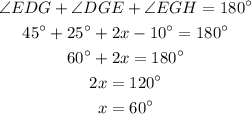Given:
1) the angle FGD and angle DGE are supplementary angles.

Also the line DE is parallel to GH and angle EDG and DGH formed supplementary angles.

Answer: x = 60 degree, y = 190 degree
2) the pair of angles of interior angles on the same sideof the transversal area supplementary.

Answer: x = 45 degree.
3) The angle BEC and CEA are supplimetary angles.

4) Angle GLK and angle EKL are supplementary,

5) B is parallel to D . and angle formed GFE and angle FED are supplementary,

Answer: x = 15 degree.
6) angle ABC and angle BCD are alternate angles and so they are equal.

Answer: x = 30 degree.